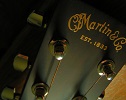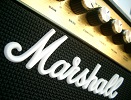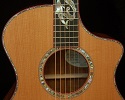Guitar Manufacturers – Luthiers & Amp makers
Quick A-Z of some Manufacturers:
|
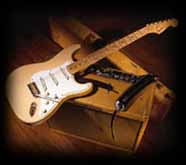
|
|
|
Guitar Tuition | Classical Guitarists | Classical Guitar Anatomy | Fender v Gibson | Telecaster vs Stratocaster
The Top 10 Guitars | Best Acoustic Guitar Under $1000 | Bass Guitar Brands
| The Rise of the Electric Guitar
– Innovative Design The guitar’s history mirrors the cultural values, Related Feature:
|
 |
Once the electric guitar had been firmly established by the 1960s and 1970s, guitar designs became increasingly distinctive and reflective of popular music trends. And by the 1980s guitarists were more and more concerned with the look as well as sound of their instruments, regarding their guitars as identifying signatures. Eddie Van Halen decorated his guitar with colored sticky tape, and Prince has had guitars of all shapes and colors custom-created for his stage performances. Today, makers of electric guitars often |
 |
Country musician Junior Brown took the customization of his guitar a step further. To solve the problem of switching back and forth between a Spanish-style electric and a Hawaiian or lap-steel electric, Brown put the two together to form a new guitar, the “guit-steel” in 1985 See the Country Music page |
- Ralph Novak: Philosophy of the Luthier
article by Dean L. Farley - I first met Ralph Novak in 1980, when he was working at Subway Guitars in Berkeley, California. I’d assembled a kit Strat and it
needed a refret. My monstrosity was painted Shell Pink in tribute to Strats from Fender’s surf era. Little did I know what was to
come of Ralph’s distant future. He was the fret guru in Berkeley, and his work was astounding – the best I’d ever seen! Ironically,
Vintage Guitar columnist Stephen White was also working at Subway at the time. So began our journey into luthiery madness!
Fast forward to 1989.In the years since, Novak has built the instruments of choice for the likes of musicians like Charlie Hunter, Phillip De Gruy, Joe
Louis Walker, and Henry Kaiser, to name a few. As time passed, he experimented with a variety of design ideas involving the use
of non-traditional woods. At times, he was viewed as downright crazy from many a purist’s standpoint. But he turned the other
cheek, seeking the solutions that would satisfy his own personal playing requirements.As a guitarist with a complete understanding of the vintage instruments he worked on, Novak wasn’t completely comfortable with
what any one instrument was capable of delivering. He wanted to combine all the features of his old favorites while adding design
twists that would give him everything he was looking for in an electric guitar. This led to the invention of his patented fanned-fret
fingerboard, which gives an instrument combined scale lengths. - Read the rest of this article by Dean Farley at the Vintage Guitar site
- (follow this direct link as the article is not linked to from the VG site – thanks Dean!)
Electric guitars have traditionally had two big measuring sticks in the Fender Stratocaster and the Gibson Les Paul. These are two traditional designs that have stood the test of time and won the respect of guitarists from many genres and generations. |
||
| Welcome to FenderWorld Where music, musicians, great instruments, audio gear and accessories come  The Fender Stratocaster |
Fender Stratocaster ‘Tex Mex’ Jimmie Vaughan signature model – $999 In many ways the Fender Stratocaster is the |
|
|
In 1997, Fender broke The plant is estimated to be
|
||
| Gibson Epiphone Les Paul Standard – $850 The Gibson style guitars generally have shorter |
Features the legendary product line as well as a collection of online magazines and resources |
|
Here are some recent Epiphone models:
- Epiphone ES 339 – a smaller ES series guitar, a double cutaway, semi-hollowbody thinline.
- Epiphone Ultra 339 – a classic semi-hollow look packed with modern features.
- Epiphone Limited Edition ES 355 – this is the basic model B.B. King’s “Lucile” was based on.
- Epiphone Limited Edition ES 345 – an affordable, yet quite respectable, version of the ever popular ES-345.
- Epiphone Ace Frehley Budokan Les Paul Custom – a recreation of the Les Paul Ace Frehley played at the record breaking Budokan KISS concert series.
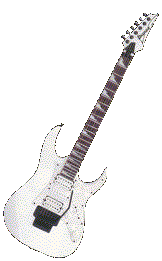 |
Ibanez – RG450DX Ibanez are one of the best known of the more Ibanez – Monstrous Metal Guitars? See Steve Vai & Joe Satriani! |
Rickenbaker – History was made with these…
The electric guitar saw its early development in the form of hawaiian guitars. Adolph Rickenbacker made one in 1931 and soon after, Leo Fender and Les Paul began working on making electric guitars of their own. The big acheivement was the electric pick-up
which changes the string’s vibrations into electricity…
In the early 1960s Rickenbacker history became forever wedded to one of the
biggest music upheavals of the 20th century: the invasion of the mop-top Beatles
from Liverpool, England. The Beatles used several Rickenbacker models in the
early years. Before the group broke up, John Lennon would own at least four. This
love affair began in Hamburg, Germany in 1960 when he bought a natural-blonde
Model 325 with a Kauffman vibrato. Lennon played the original (which was
eventually refinished black but still easily identified by its gold-backed lucite
pickguard) on all Beatle recordings and in all concerts until early 1964.
While Paul’s Rick bass surged like an undertow, George Harrison’s double-bound 360/12 (the second one
made by the company) defined a new tone at the other end of the audio spectrum. Its ringing sound
embellished “You Can’t Do That,” “Eight Days a Week,” and “A Hard Day’s Night,” to name just three
12-string cuts from the 1964-65 period. Thus the Beatles created unprecedented, international interest in
Rickenbackers, which many fans actually believed came from Britain… (Before 1964 all Rickenbacker guitars had been
made at the original Electro String factory in Los Angeles. That year Hall moved it over a six month period
to Santa Ana, in nearby Orange County. )
The Vox Show Room shows the classic amps behind the British Explosion of sound in the 60’s. VOX, at one time was one of the largest
musical instrument producers in the world and their products were utilized by
almost every major music group during the nineteen sixties. From The
Shadows to The Beatles to U2, VOX is the “voice” of
generations of musicians worldwide.
Augustino Lo Prinzi Guitars –
Augustine Lo Prinzi has made more than 10,000 guitars and just started his 49th year as a guitar maker! Renowned throughout the instrument making field, Augustino LoPrinzi’s first
instruments were classic guitars. As his career progressed he constructed many
types of string instruments, numbering in the thousands : mandolins, lutes,
violins, and steel string guitars, to list but a few. Now he is applying these years of
wisdom to his first love, the classic guitar, which began his journey into instrument
making.
| Chabot Guitars – Paul Chabot used to offer quality hand made Classical guitars (Colorado, USA) “Paul first apprenticed und
er guitar maker / repairman Robert Buchanan, where he became familiar with the aspects of guitar repair, and guitar refinishing. Furthering his ability and knowledge, Paul attended Roberto-Venn School of Luthiery where he learned the basics of wood, instrument design and guitar making. |
 |
Not long after graduating from Roberto-Venn, Paul was fortunate enough to apprentice under world renowned Master guitar maker Augustino Lo Prinzi. Through Augustino Lo Prinzi, Paul was able to learn some of the most proven methods and advanced techni ques of fine guitar making.” <<< Chabot Parlor Classic |
C.F. Martin & Co. – Martin is one of the oldest acoustic guitar manufacturers in the world, and it continues to be a family owned business. It was founded by C F Martin in 1883, and was the pioneer designer of the popular dreadnought shape. Up to now, Martin produces the most sought after acoustic guitars in the market.
Maton Guitars – Australia’s leading manufacturer of Acoustic and Acoustic / Electric Guitars. Until the late 1930’s the Australian guitar manufacturing industry was virtually non existent and good quality guitars were hard to find. The best guitars, it was well understood, came from the U.S.A. Bill May, a Melbourne born jazz musician, woodwork teacher, and luthier, decided to change all that.
Manne guitars – This Italy based guitar manufacturer produces instruments with unique features. The first Manne guitar was built in 1986 and they continue to provide finely crafted instruments based on some very original design concepts. Manne’s design philosophy: hand craft the finest stringed instruments then offer them to the public at a reasonable price.
Epiphone – Before being bought out by Gibson in the late 1950s, Epiphone was actually Gibson’s main rival in the archtop market. Now they are known for producing more affordable alternatives to Gibson branded models like the Les Paul, SG etc.
RainSong – If you are looking for environmentally friendly guitars, then feast your eyes on the various all-graphite (carbon fiber) instruments from this US based manufacturer.
Peavey – Hartley Peavey started Peavey electronics in 1965, it went on to one of the largest musical instrument and audio equipment manufacturer in the world. They offer a multitude of guitars, amps and related gear, and the price point they use are comparatively very reasonable. One of their latest guitars, the Peavey AT-200, has the guitar world talking about its innovative auto-tune feature.
Washburn – With a long history that dates back to 1883, Washburn makes various types of guitar related products including electric, acoustic, bass, amps, banjos, mandolins and amplifiers. Their old acoustic guitars were involved with Delta blues back in the 1920s, while now, they are recognized mostly for their metal/rock friendly electric guitars.
Lakewood Guitars – These are German made high-end acoustic guitars that are expensive. They offer beautifully manufactured instruments in a range of body sizes. Try out their cool online guitar designer that will let you build your guitar online and it shows you a 3D view of how your guitar would look like.
G & L Guitars – Leo Fender founded this US Based guitar company with then-partner George Fullerton (hence the name G & L. They offer guitars similar to classic Fenders, but with some modern innovations. It is said that if Leo Fender stayed with Fender, their instruments will be upgraded to the G&L designs, which he considers as an upgrade to his classic guitar creations.
Cort Guitars – Cort is known for their reasonably priced instruments and gear. They have a wide range of instruments available worldwide from rocking-out solids to traditional acoustics.
Paul Reed Smith – PRS guitars are relatively new, but it is more than capable to challenge more established brands, and has continued to climb in popularity. They offer a full range of instruments that follow their distinct shape, which combines Gibson’s aesthetics with Fender’s versatility and playabiltiy.
Carvin – Like Peavey, Carvin spreads itself for the various niches of the audio market, building guitars, basses, amplifiers and pro audio gear, and they have been in this business for more than 60 years. The quality of their custom-made bass and guitars is well received by many.
Takamine – This Japanese guitar manufacturer is known for their acoustic-electric instruments. They are one of the first few companies that implemented acoustic-electric models, and played a pioneering role in the design of the preamp-equalizer component, which are now common place.
Godin Guitars – Robert Godin heads this Canadian based guitar manufacturer that offer acoustic and electric guitars. Their ability to produce instruments that offer innovation and quality while retaining affordability, helped propel them to their brand’s worldwide reach.
ESP Guitars – The ESP brand has risen to popularity especially in the rock and metal arena, thanks to endorsements from Metallica and other artists such as George Lynch and Kerry King. They also offer guitars in more traditional forms and configurations, but with their own distinct twist.
Fury Guitars – Founded in 1962, this manufacturer is considered as one of the first ones to produce electric guitars in Canada. They continue to build unique looking electric guitars that include standard 6-strings, 12-string, baritone and bass with drop D.
Brian Moore – Known for their innovative custom electronics and distinctive designs, Brian Moore Guitars continue to produce guitars that go beyond the conventional. Aside from their custom-built instruments, they now carry a host of artist signature models. One of their more popular products is the iGuitar, which feature acoustic MIDI, piezo, 13 pin Synth and more.
Allen Guitars – Every Allen instrument is individually hand-crafted. Nothing is mass-produced. The hand carving of the braces, the painstaking and careful construction process result in a signature sound that many continue to approve. Allen Guitars also upply exotic tonewoods, abalone shell inlay, ebony fretboards and other luthier needs.
Snarling Dogs – If you saw a wah pedal that has a foot-shaped footpad, then you are looking at a Snarling Dogs’ designed wah. They also offer various types of guitar and bass strings. Their products are now available from D’Andrea.
MDX Custom Guitars – The man behind this custom guitar workshop is Dwight Maddox. They’ve been building unique guitars that follow exactly what their customer want, from shape to hardware to electronics.
National Reso-Phonic Guitars – World renowned for their resonator instruments. Unlike acoustic guitars, where the vibration of the wooden body creates the sound, in a resonator instrument the body acts as a speaker cabinet. When the strings are plucked, the vibration is transmitted through the saddle to the resonator. The resonator, or speaker cone, then amplifies that vibration.
Vox Amps – Vox is one of the largest musical instrument producers in the world and their products were utilized by almost every major music group during the nineteen sixties. From The Beatles to Lawrence Welk, VOX was the “voice” of a generation of musicians worldwide. Now they continue to produce their distinctive amps and effects, embracing modeling technology while retaining tube amp products, and at times combining them. They also produce instruments and other guitar/bass related gear.
Ampeg – Ampeg is a guitar and bass amplifier manufacturer that was known for their loud and powerful bass amps. They are now under the Mackie brand and continues to produce sought after amplifiers and cabinets for bassists.
Matchless – Matchless was founded in 1989 with the aim of creating versatile amplifiers for guitar players. Their class A tube circuitry is sought after along with the workmanship quality exhibited by their products.
Marshall – This British company is one of the most recognized brands in amplification, thanks to the many artists that made the “Wall of Marshalls” a staple of their performances. The Marshall “crunch” tone has made its way to many iconic recordings, and continues to be a standard by which overdrive/distortion effects are measured with.
Seymour Duncan – Pickups designed by Seymour Duncan first appeared in Floyd Rose equipped Kramer Guitars at the height rock, new wave and shred era. Now they produce all sorts of pickups that cover a variety of electric guitar and bass guitar models, both in single coil and humbucking format.
Guild Guitars – Guild is a well known acoustic guitar manufacturer. The brand was acquired by Fender in 1995, and has continued producing archtops and acoustics. Guild recently released a new Doyle Dykes signature model.
Conde Hermanos-Eseso – Established in 1915, this flamenco and classical guitar manufacturer has a nearly 100 year old guitar making tradition. They now offer various classical and flamenco models, including ones with modern cutaway features. They also create custom guitars for their customers.
Wechter Guitars – Abe Wechter has been designing and building guitars for 22 years. It has been a long journey from his first guitar shop in Seattle, Washington, to his current shop in rural Van Buren county Michigan.
Daedalus Music – This New York based workshop produces cabinets and speaker systems for musicians. They sell and manufacture acoustic guitar amps and cabinets using handcrafted renewable North American Hardwoods. The name Daedalus is based on a skillful artist and inventor as found in Greek legends.
Breedlove Guitars – This Oregon-based guitar manufacturer produces beautifully hand-crafted acoustics. Their site offers in-depth information on products and prices, as well as offering company and acoustic music information and news.
Fuzzy Pedal Steel Guitar Products – This tokyo based workshop is headed by Mitsuo Fujii, and it is the brand behind the Excel series of pedal steel guitars. They also offer Jerry Byrd signature instruments.
Guild of American Luthiers – Aside from publishing the world’s foremost lutherie magazine – American Lutherie, this site offers a lot of useful information for custom guitar makers and prospective buyers.
The Ultimate Guitar Repair Shop – Gene Liberty has been working in the Northern Illinois area with over 25 years of full time guitar repair and custom building experience. Also specializing in the design and custom building of tools, fixtures and machines specific to guitar repair and guitar building.
Larry Robinson Fine Custom Inlays – They produce one-of a kind shell inlays for all kinds of guitars. One of a handful of inlay practicioners in the country, Larry has done exquisite work for major guitar manufacturers (Fender, gi bson, Yamaha,…), small production shops (Santa Cruz, Collings, etc.), single luthier shops (Klein, Ryan, Olson, Megas, and more), collectors like Tsumura and people who just want something to personalize their guitar.
Wait – There’s much more!
See which manufacturers made the Top 5 Electric Guitar Brands list.
Something to please your neighbors when you practice? Silent Guitars
Additional Resources

